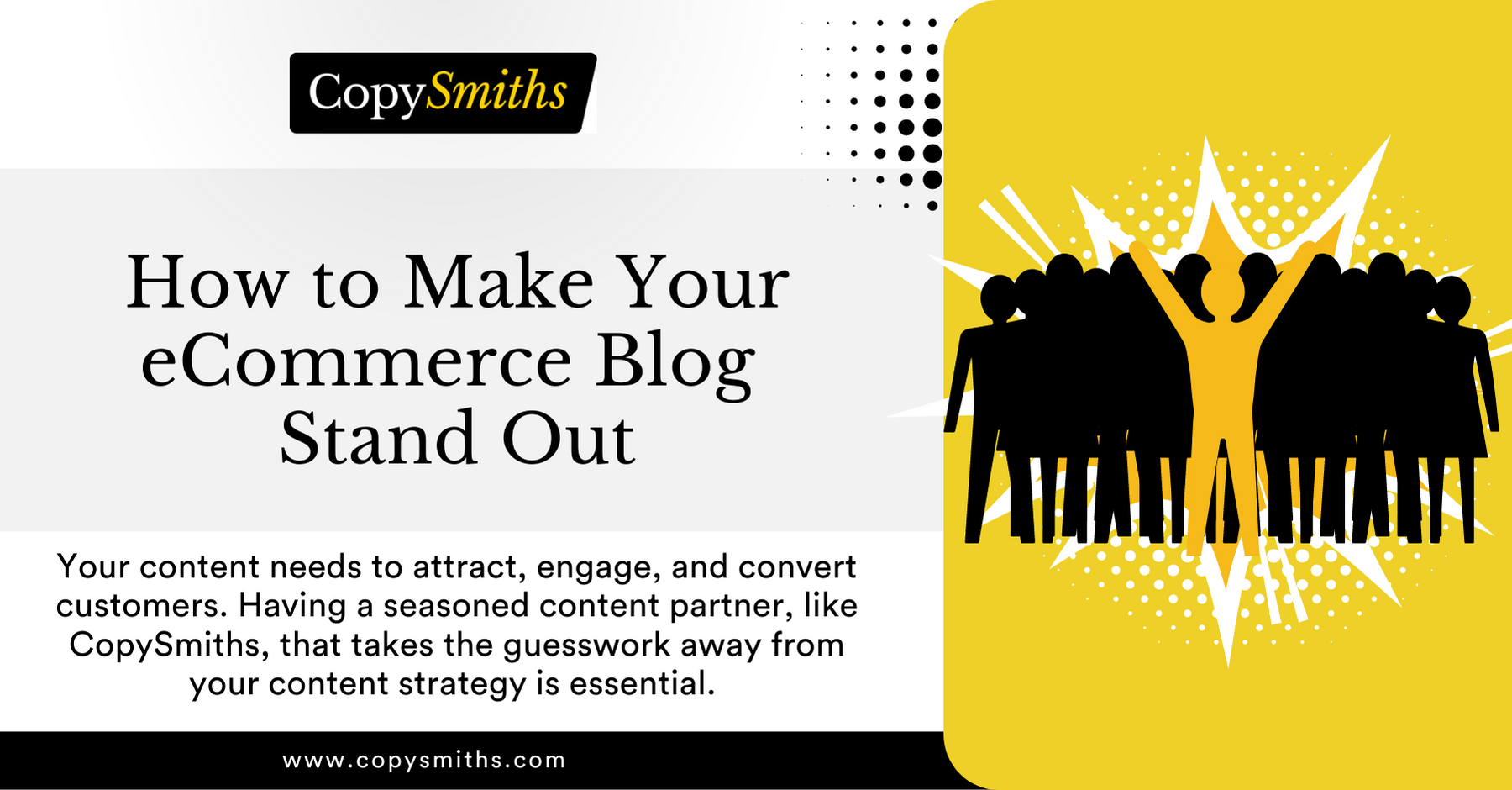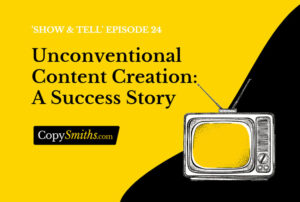Home » Content Marketing » How to Make Your eCommerce Blog Stand Out

How to Make Your eCommerce Blog Stand Out
The not-so-great news is that your target customers are drowning in noise.
They’re often interacting with content from multiple brands, all competing for their attention. These brands understand how much quality blog content can do for their eCommerce stores.
A strong content marketing strategy helps B2C marketers achieve:
- Creating brand awareness
- Educating their audience
- Building credibility and trust
- Generating demand and leads
The good news for you is that most of these brands are winging it. They’re churning out a lot of content to see what works, but guesswork can only take them so far.
If you want to create an eCommerce blog that makes your brand stand out, you need to be intentional with your content strategy.
Your content needs to attract, engage, and convert customers. Having a seasoned content partner, like CopySmiths, that takes the guesswork away from your content strategy is essential.
Here are a few pointers to help you create blog content that yields results.
Research What Customers Want to Read
With 97% of customers starting product research online, you have a treasure trove of information to draw insights from.
Some of your target customers will start their research on Google. Others will head to social media and forums to ask questions. The trick is to find your blog content ideas right where your customers are.
Here are three places where you’ll find ideas for your eCommerce blog:
Consumers trust Google to provide them with the information they’re looking for, and that’s what makes it a great place to find content ideas.
Search for the keyword you’re looking to write content about, and head to the ‘People also ask’ section. This is a great way to get an idea of what information people are looking for. You can then turn these ideas into blog titles or use them to create FAQ sections on your blog posts.
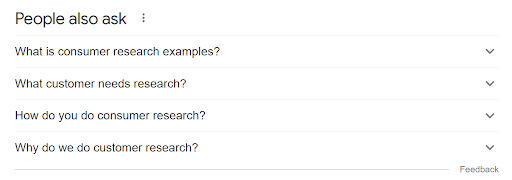
Source: Google Search
Social Media and Industry Forums
Reddit, Twitter, Instagram, LinkedIn, and industry forums can be great sources for finding valuable content ideas. Since they’re based on a social setup, you can find more than ideas.
Depending on how people describe their problems, you’ll be able to understand their key pain points. From this information, you can then create content that provides your audience with solutions to their problems.
The trick is to determine which platforms your audience uses most. To do this, simply ask your customers on your social media pages or have them fill out a customer survey.
You can then use platform-specific tactics to identify what they’re talking about. For instance, you can find content ideas by searching hashtags on Instagram or by using a boolean search on industry forums.
Your Customer Support Team
Your customer support team is at the frontline of your business. Customers approach them with their questions and product concerns. Talk to your team about what customers are asking about most and create content that aligns with these themes.
Let Your Customer’s Purchase Journey Inform Content Creation
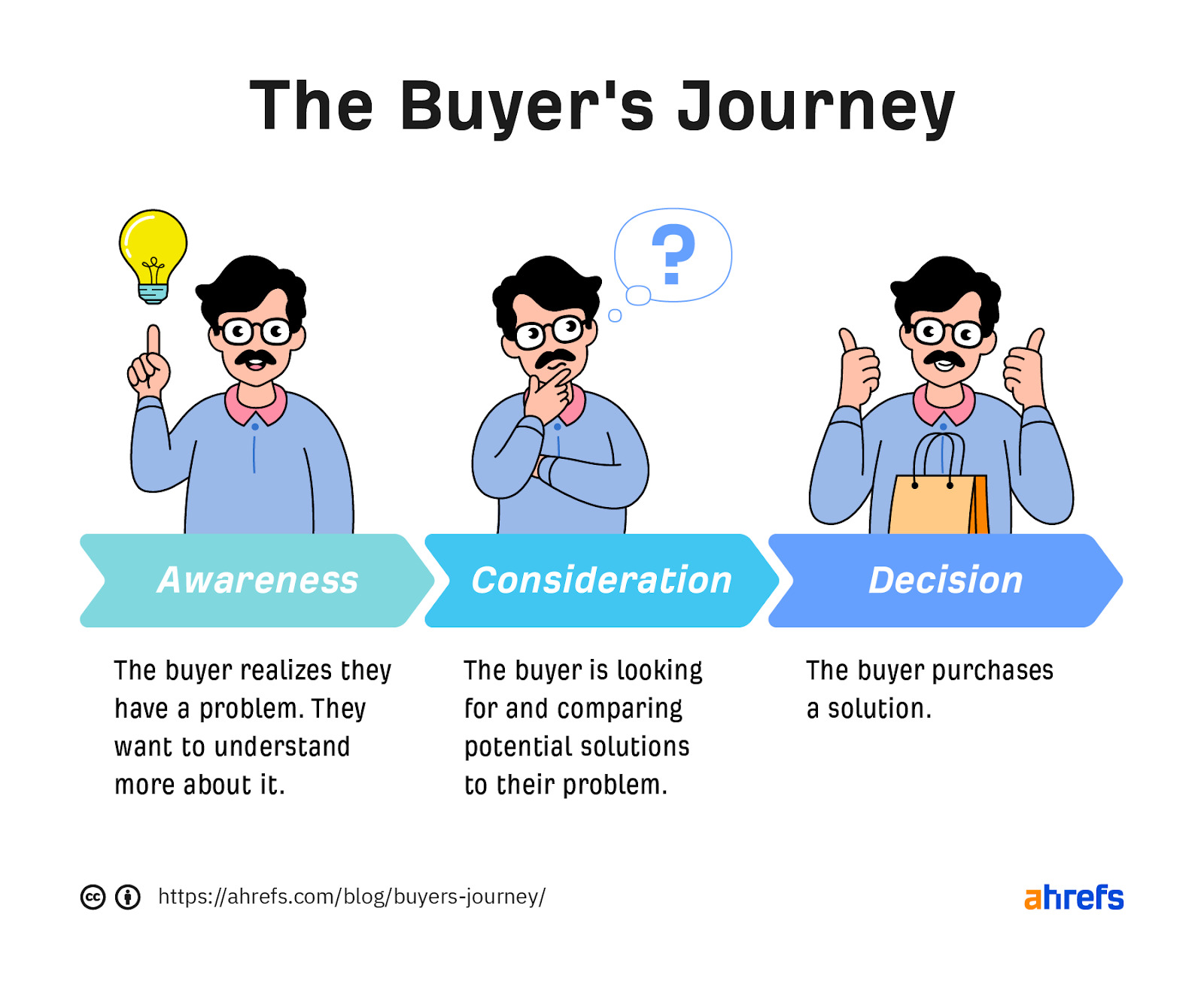
Source: Ahrefs
A one-size-fits-all approach to content creation will only take you so far. Creating content based on your customers’ purchase journey (or buyer’s journey) ensures that you’re directly addressing their intentions. The image above shows you the various stages of the customer purchase journey.
While some customers are just learning about the problem they have, others already know about available solutions and are ready to make a purchase. Different forms of blog content will be useful for each customer journey stage.
Create content that will pique their interest at each stage and make your business look credible. Doing so will improve the chances of them approaching your business at the next purchase stage.
Here’s a simple breakdown of the customer purchase journey as well as some ideas about what content to create based on each stage:
The Awareness Stage
While some customers will be problem-aware, others might not even know that they have a problem. This is not the stage for hard-selling your product.
Your blog posts at this stage should focus on engaging and informing customers. You need to talk more about the problems they’re facing and potential solutions. Adding a call-to-action that soft-sells your business’ solution will be great at this stage.
Focus on content like:
- How-to guides
- Industry studies
- Infographics
- eBooks
The Consideration Stage
Your customer is problem-aware and knows about the available solutions. The goal of your blog content at this stage is to help your customers compare products or solutions.
You’ll also need to position your product or services as an undeniable option for them. Since your customer is still looking for the best option, try to be more educational than salesy.
Some great content types for this stage are:
- Product reviews
- eBooks
- Product/solution comparisons
- Case studies
- Whitepapers
The Decision Stage
Your target customer has already zeroed in on a few viable solutions. They completely understand the problem they face and know what their ideal solutions are.
The goal is to show your customers that yours is the best solution out of the few they’re considering. It’s okay to hard-sell at this stage.
Some of the best content types to use are:
- Customer case studies
- Tutorials (for hard-to-understand products)
Expert Tip: Including customer testimonials at this stage is a great way to improve customer trust.
Build Trust Through Your Blog Content
Trust can be a game-changer for your business. In fact, 81% of customers consider how much they trust a brand before purchasing from them, according to the 2019 Edelman Trust Barometer Special report.
The same report also shows that customers who trust a specific brand are likely to stay loyal and act as brand advocates and defenders.
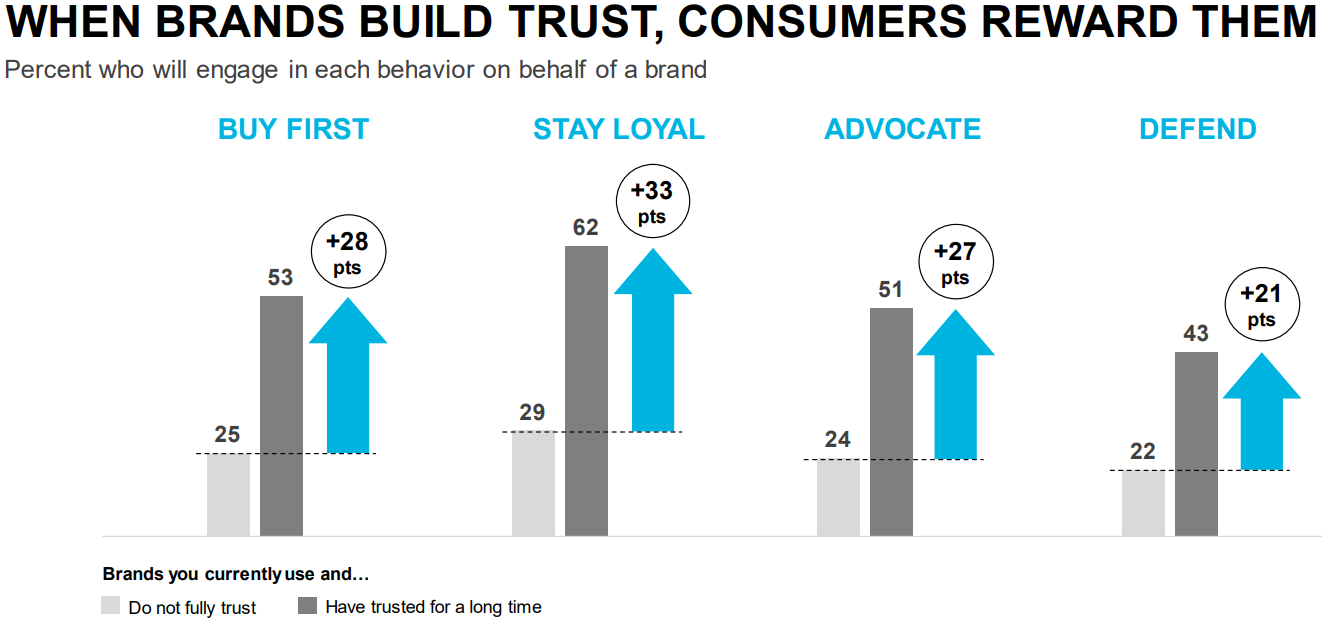
Source: 2019 Edelman Trust Barometer Special Report
Building trust through a blog requires you to move away from run-of-the-mill content. Your content should give customers a fresh perspective and contain a few trustworthy elements. You can always learn more about these trust elements on our Content Buyers’ Guide.
Enrich your blog content with trust elements like:
Statistics and Studies
Back up your content with timely and relevant statistics and studies. You can perform these studies yourself, by talking to your customers, or look for them on Google—but remember to cite them properly if you do.
Adding either of these two trust elements makes your blog seem less like hearsay. It makes customers feel confident that you’re an expert they can trust.
Expert Interviews and Customer Quotes
Featuring expert insights on your blog posts does more than improve your content’s credibility. It widens your network, increasing the chance of such experts promoting your content. Even better, you’ll create content that has varying perspectives, making it less biased.
As for customer quotes or testimonials, you get to include social proof right in your content. This makes your content more relatable to customers—they’ll see their struggles and future outcomes through the experiences of others.
When a customer makes a purchase, it’s a good idea to ask them to leave a testimonial that you can reference later on.
Provide Real-World Examples
Prove your points with relevant examples. Real-world examples make the solutions you’re suggesting seem easy to achieve.
However, avoid examples that are low-hanging fruits. For instance, it’s very easy for someone writing about eCommerce to reference Amazon as an example, but the audience might not completely relate to it.
Work with examples that are close to your target customers’ experiences, something relatable (such as a common pain point) about the product they’re thinking of buying. Talk to them about how others have experienced that pain point and how they found a solution.
Promote Blog Content at Different Brand Touchpoints
“The days of ‘write it and they will come’ are long gone, if they were ever here to begin with… After all, the formula is: content + marketing = qualified leads.” — Neil Patel, founder of Neilpatel.com.Start your content promotion journey by determining which brand touchpoints to focus on.
This table shows you how to promote content at three touchpoints:
| Touchpoint | Content Promotion Tips |
| Social media |
|
| Email marketing |
|
| SEO |
|
Create Valuable Content
Your customers are interested in valuable content. They want content that addresses their pain points and offers valuable solutions to their problems. Most importantly, your content should promote your products or services as an ideal solution for your customers.
If you’re looking for content that attracts, engages, and converts customers, contact CopySmiths today. We can help you create valuable content at scale.
Share on LinkedIn:
CopySmiths
I'm Katrina McKinnon, founder of CopySmiths and Small Revolution. In my 20 years of experience, I have helped online businesses create high-performing content specifically on an eCommerce store's blog. Find me on LinkedIn and Twitter.

CopySmiths offers the best blog writing services for online stores.
If you'd like us to write blog articles for you, click here.
Most Recent
- 3 Bold Questions You Should Ask When Hiring A Content Writer

- 5 Practical Reasons You Should Use a Blog Post Template

- 4 Amazing Benefits of Using a Title Generator for New eCommerce Blogs

- 10 Awesome Bio Examples Your Online Store Blog Should Emulate

- 8 Basic Steps to Successful Content Development Every Time

Podcasts
Got a question?
Ask our friendly team about our article writing services.
Subscribe to CopyZine
Monthly, hand-picked stories of the best in eCommerce Content.

